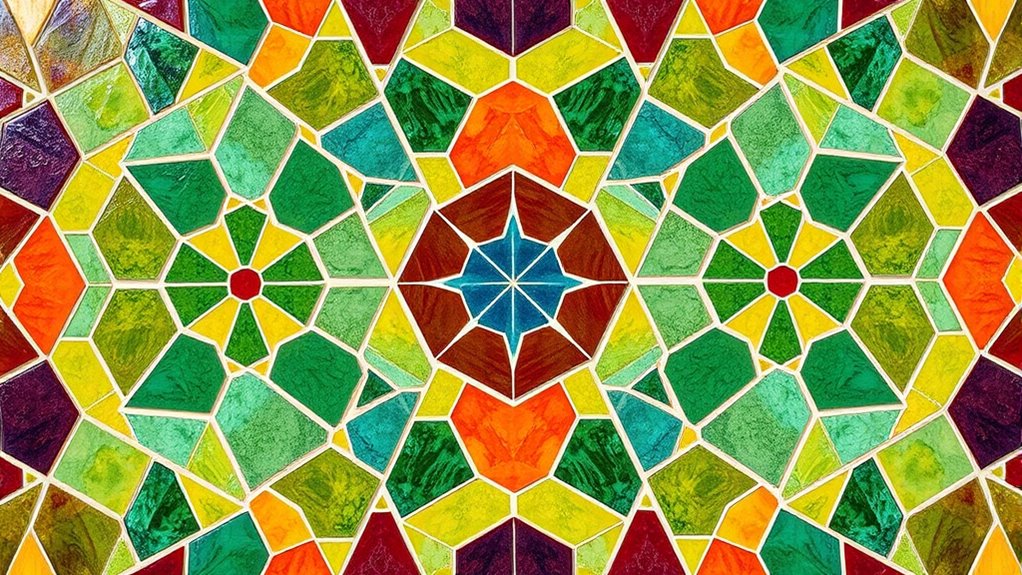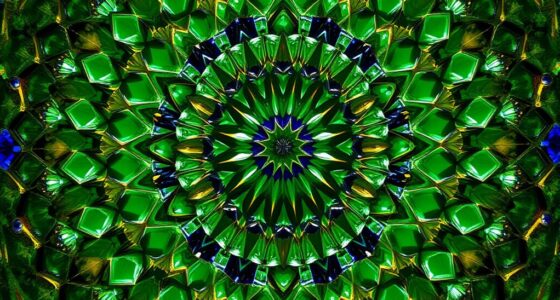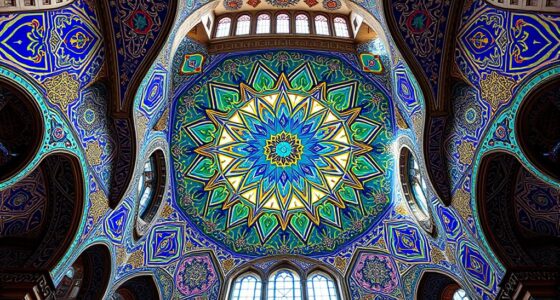Symmetry and tessellation play key roles in creating eye-catching patterns in art and design. Symmetry offers balance and harmony, whether through mirror images or circular layouts, while tessellations fill space with repeating shapes that fit perfectly together. These principles influence styles from cultural motifs to modern architecture. By exploring how artists and designers use these techniques, you’ll gain insights into crafting visually appealing and structurally sound works, guiding you to discover even more creative possibilities.
Key Takeaways
- Symmetry creates visual balance in art, including bilateral, radial, and rotational types that guide viewer focus.
- Tessellations use repeating geometric or organic shapes to cover surfaces without gaps, reflecting mathematical and artistic principles.
- Cultural motifs influence pattern design, with symbols and shapes representing traditions, beliefs, and historical significance.
- Modern architecture incorporates symmetry and tessellation for aesthetic appeal, structural stability, and innovative forms using digital tools.
- Digital design tools facilitate experimentation with symmetry, tessellation patterns, color, and layering for complex, professional artwork.
The Principles of Symmetry in Artistic Creations
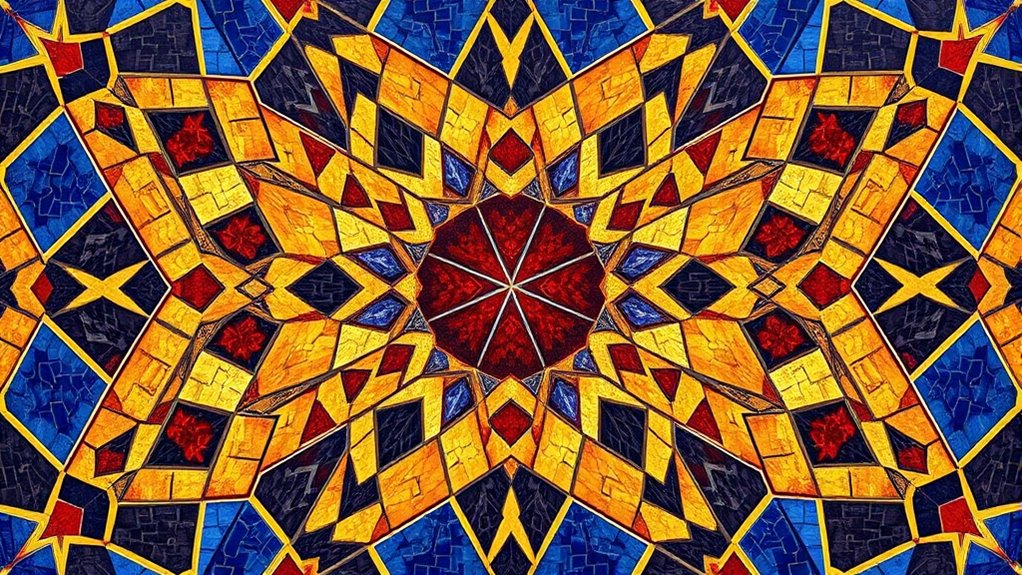
Have you ever wondered how artists create a sense of balance and harmony in their work? It all comes down to understanding the principles of symmetry. Symmetry helps achieve visual harmony by ensuring elements are arranged with balance and proportion. When an artwork exhibits symmetry, each side mirrors the other, creating a cohesive and pleasing composition. This approach guides the viewer’s eye smoothly across the piece, making it easy to interpret and enjoy. Symmetry can be radial, bilateral, or rotational, but in all cases, it fosters a sense of stability and order. By mastering symmetry, artists craft compositions that feel natural and balanced, drawing viewers in and engaging them with a sense of harmony that resonates visually. Additionally, understanding the different types of symmetry can enhance the overall design by creating more dynamic and engaging visual effects.
Types of Tessellations and Their Origins

Tessellations come in various types, each with unique patterns and origins that reflect different cultural and mathematical influences. Regular tessellations use uniform shapes like squares or triangles, while irregular tessellations feature more complex, asymmetrical patterns. Organic pattern origins often produce irregular tessellations inspired by natural forms such as leaves, shells, or stone formations. These irregular designs mimic nature’s unpredictability, creating a sense of movement and fluidity. Some tessellations derive from mathematical principles, like Penrose tilings, which use non-repeating patterns to challenge traditional symmetry. Others develop through artistic experimentation, blending geometric and organic elements. Recognizing these types helps you appreciate the diversity of tessellations, from precise mathematical constructs to natural, organic patterns rooted in the environment. Understanding tessellation types enhances appreciation for their diverse origins and applications across art and design.
Cultural Influences on Pattern Design
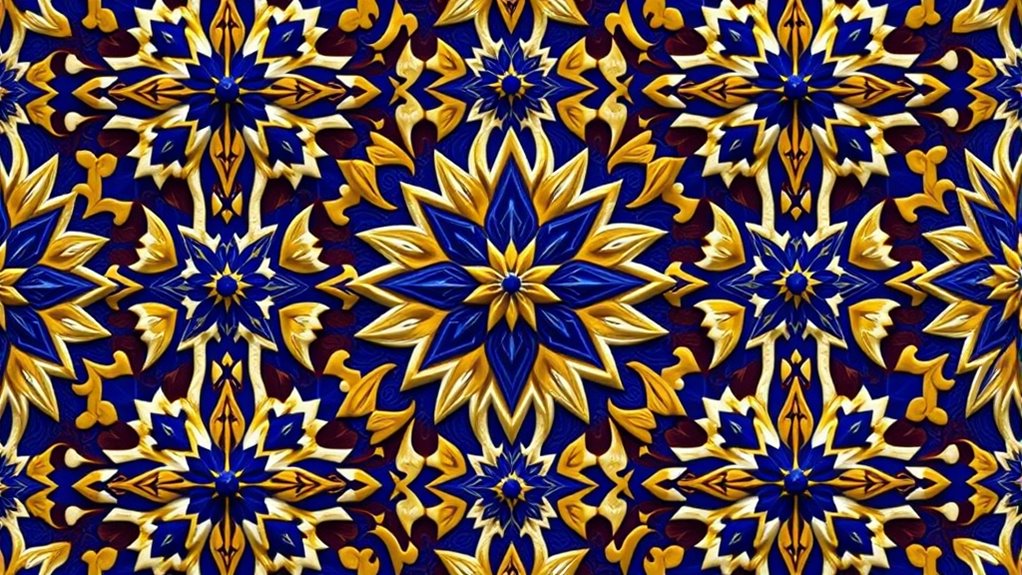
What role does culture play in shaping pattern design? It influences the symbols and motifs you see, embedding meaning through cultural symbolism and traditional motifs. Different societies use specific patterns to express spiritual beliefs, social status, or historical stories. For example, Celtic knots symbolize eternity, while Islamic geometric designs reflect spiritual harmony. These patterns often carry deep significance, connecting past and present. You’ll notice that cultural influences shape not just the aesthetics but also the purpose of designs. By studying these motifs, you gain insight into a community’s identity and values. Additionally, understanding Cultural Intelligence helps designers appreciate the cultural context behind patterns, ensuring respectful and authentic representations. As you explore patterns worldwide, you’ll see how cultural symbolism transforms simple shapes into powerful visual narratives that resonate across generations.
Applications of Symmetry and Tessellation in Modern Architecture

Modern architecture leverages symmetry and tessellation to create visually striking and functionally innovative structures. Parametric modeling allows architects to design complex, symmetrical patterns that adapt seamlessly to building forms, enhancing both aesthetic appeal and structural efficiency. Tessellation principles help optimize space use, enabling repetitive, interlocking designs that improve stability and visual harmony. You can incorporate sustainable materials into these designs, ensuring eco-friendly construction without sacrificing beauty or functionality. These materials, such as recycled metals or green concrete, work well with symmetrical and tessellated patterns, emphasizing durability and environmental responsibility. Additionally, floating on water can inspire innovative architectural solutions that integrate seamlessly with natural aquatic environments. By applying these concepts, you develop buildings that are not only eye-catching but also innovative in their use of space and resources, reflecting a modern approach that values both form and sustainability.
Techniques for Creating Intricate Pattern Work

Creating intricate pattern work involves a combination of precise techniques and artistic vision. Start by selecting a harmonious color palette that enhances the pattern’s complexity and visual appeal. Incorporate geometric abstraction by breaking down designs into basic shapes like triangles, circles, or polygons, ensuring symmetry and repetition. Use grid systems or templates to maintain consistency and accuracy in your motifs. Pay close attention to spacing and alignment, which are essential for seamless tessellation. Layering colors and shapes can add depth and intricacy, making patterns more engaging. Practice sketching and refining your designs repeatedly, focusing on balance and rhythm. By mastering these techniques, you’ll craft detailed, mesmerizing patterns that exemplify both technical skill and creative expression.
The Role of Digital Tools in Pattern Design
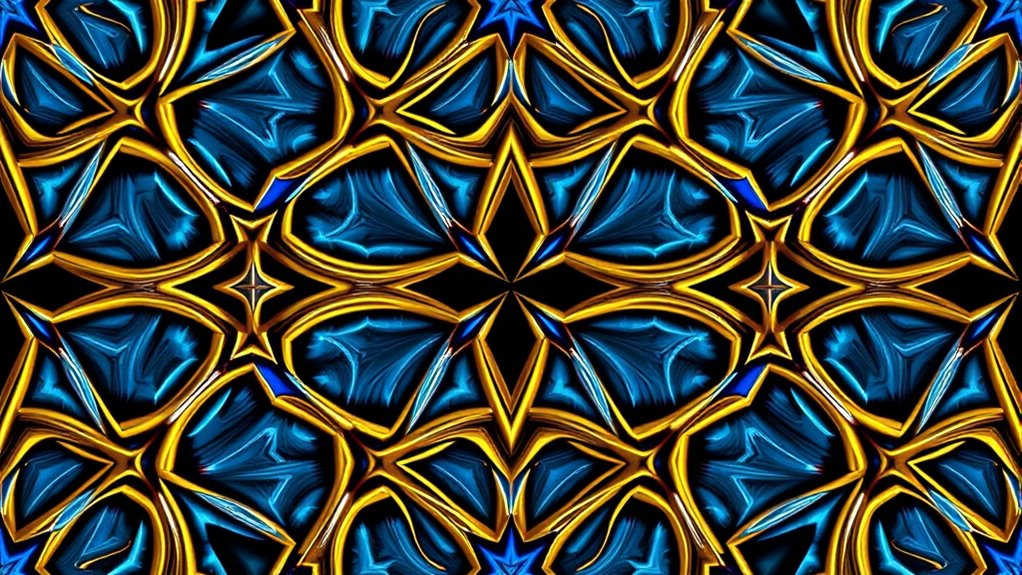
Digital tools have revolutionized pattern design by providing artists and designers with powerful, versatile options for creating intricate and precise motifs. With digital patterning, you can experiment with complex symmetry, tessellations, and repetitions effortlessly. Software innovations, like vector-based programs and algorithmic design tools, enable you to manipulate motifs easily, ensuring perfect alignment and consistency. These tools also streamline the creative process, allowing you to quickly test different color schemes, scales, and arrangements. Digital patterning removes technical barriers, so you can focus on artistic expression. From textile design to wallpaper creation, digital tools expand your possibilities, making intricate, professional-quality patterns accessible. Additionally, understanding symmetry and tessellation principles helps in designing harmonious patterns that are visually appealing. Ultimately, they transform traditional techniques into dynamic, innovative designs that enhance modern art and architecture.
Frequently Asked Questions
How Does Symmetry Influence Viewer Perception in Art?
Symmetry influences your perception of balance in art, making compositions feel harmonious and stable. When you see symmetrical designs, you often experience a sense of calm and order, which heightens the emotional impact of symmetry. This natural tendency to seek balance guides your eye across the artwork, reinforcing feelings of unity and coherence, and allowing you to connect more deeply with the artist’s intended message or mood.
Which Ancient Civilizations First Developed Tessellation Techniques?
Imagine you’re scrolling through ancient Egyptian murals. The civilizations that first developed tessellation techniques include the Egyptians and Mesopotamians. They created intricate mosaics and patterns, using repeating shapes that fit together perfectly, forming mesmerizing designs. These early artists understood how to use repeating geometric motifs, laying the foundation for tessellation in art. Their work demonstrates an impressive mastery of pattern, influencing countless cultures and artistic styles that followed.
Can Symmetry and Tessellation Be Used to Convey Cultural Identity?
You can use symmetry and tessellation to convey cultural identity and symbolism effectively. These patterns reflect traditions, beliefs, and values, serving as visual representations of cultural identity. By incorporating specific motifs and arrangements, you communicate a community’s story or heritage. This approach helps preserve cultural symbolism, allowing viewers to recognize and connect with cultural identity through intricate, meaningful designs that resonate deeply within a society’s artistic expression.
What Are Emerging Trends in Digital Pattern Creation Tools?
You’re exploring emerging trends in digital pattern creation tools, where generative algorithms play a key role. These algorithms enable you to create complex, unique patterns effortlessly. Additionally, immersive interfaces like augmented reality and virtual reality are transforming how you interact with designs, making the process more intuitive and engaging. Together, these advancements empower you to experiment more freely, pushing the boundaries of digital pattern creation and innovation in your artistic projects.
How Do Artists Break Traditional Symmetry Rules for Creative Effect?
Imagine breaking free from perfect mirrors, like asymmetry in sculpture that creates dynamic, unexpected forms. You can experiment with organic tessellations, where irregular patterns flow naturally, defying traditional rules. By intentionally disrupting symmetry, you evoke movement and emotion, making your art more engaging. You challenge viewers’ expectations, inviting them to explore deeper layers of meaning and discover beauty in chaos and imperfection.
Conclusion
Think of symmetry and tessellation as the threads weaving through the fabric of art and design, creating a vibrant tapestry of creativity. When you understand these principles, you become a skilled weaver, crafting intricate patterns that captivate and inspire. Embrace the endless possibilities they offer, and let your imagination flow freely. Like a master artist, you can turn simple shapes into mesmerizing masterpieces that celebrate harmony and beauty across cultures and eras.
